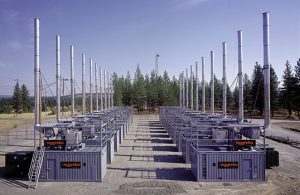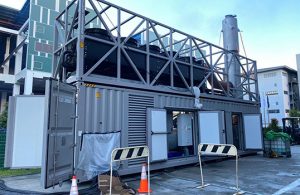Container substations, also known as mobile or prefabricated substations, are an increasingly popular solution in the field of electrical power distribution. These substations are housed in container-like enclosures, which makes them easily transportable and adaptable to a variety of environments. The flexibility, cost-effectiveness, and rapid deployment capabilities of container substations make them a crucial asset in industries where power demands can change rapidly or in areas where constructing a traditional substation would be impractical.
Overview of Container Substations
A container substation is a compact, modular unit that contains all the necessary electrical components typically found in a traditional substation, such as transformers, switchgear, protection devices, and control systems. These components are pre-assembled and integrated within a container, often a standard ISO (International Organization for Standardization) shipping container, making transportation to the site easy and efficient. Once on-site, they can be quickly connected to the power grid and begin operation, providing a reliable power supply in a short period.

Key Components of a Container Substation
- Transformer: The transformer is the heart of the system, converting high-voltage electricity from the transmission network into lower voltages suitable for distribution. Depending on the application, the transformer can be designed to handle various power capacities.
- Switchgear: This component is responsible for controlling, protecting, and isolating electrical equipment within the substation. Switchgear in a container substation typically includes circuit breakers, disconnect switches, and fuses, all designed to ensure the safe operation of the substation.
- Protection Devices: Protection devices are essential for preventing damage to the substation and the wider electrical network. These devices monitor the electrical current and can automatically disconnect the substation from the grid if they detect a fault, such as a short circuit or overload.
- Control Systems: These manage the operation of the system and communicate with the central control room, allowing for remote monitoring and control, which is particularly useful in remote or difficult-to-access locations.
- Cooling and Ventilation Systems: They are enclosed spaces, they require effective cooling and ventilation systems to prevent overheating of the electrical equipment. These systems are typically integrated into the design of the container to ensure optimal performance in various environmental conditions.
Advantages of Container Substations
1. Portability and Flexibility
One of the most significant advantages of a container substation is its portability. The entire substation can be transported to the desired location using standard shipping methods, making it ideal for temporary or emergency power needs. The modular design also allows for easy expansion or relocation as power demands change.
2. Rapid Deployment
Traditional substations can take months or even years to construct, depending on the size and complexity of the project. In contrast, these prefabricated units are pre-assembled and tested in a factory environment, allowing them to be deployed and operational within weeks. This rapid deployment is particularly beneficial in emergency situations, such as natural disasters, where restoring power quickly is critical.
3. Cost-Effectiveness
The cost of constructing a traditional substation can be prohibitively expensive, especially in remote or difficult-to-access locations. These modular systems offer a more cost-effective solution by reducing the need for extensive civil works and on-site assembly. The ability to reuse and relocate them also adds to their cost-effectiveness over time.
4. Reliability and Safety
They are designed to meet the same reliability and safety standards as traditional substations. The enclosed design of the container provides protection from environmental factors such as dust, moisture, and temperature extremes, ensuring the safe and reliable operation of the substation in a variety of conditions.
5. Customization and Scalability
These systems can be customized to meet specific requirements, whether for industrial, commercial, or residential applications. The modular design allows for easy scalability, meaning that additional units can be added as power demands increase. This flexibility makes them an attractive option for industries with fluctuating power needs.

Applications of Container Substations
They are used in a wide range of applications, from providing temporary power during construction projects to supplying electricity to remote mining operations. Some common applications include:
- Remote Areas: In remote or rural areas where constructing a traditional substation would be impractical or too costly, they provide a reliable and efficient solution. They can be used to power remote communities, industrial operations, or military installations.
- Emergency Power: During natural disasters or other emergencies, they can be rapidly deployed to restore power to affected areas. Their portability and quick deployment make them an essential tool in disaster recovery efforts.
- Construction Sites: Construction projects often require temporary power solutions, particularly in the early stages before permanent electrical infrastructure is in place. They can provide a reliable source of power throughout the construction process and can be relocated as needed.
- 産業用途: Industries with high power demands, such as mining, oil and gas, and manufacturing, often require flexible and scalable power solutions. They can be customized to meet the specific needs of these industries and can be easily expanded or relocated as operations change.
- Urban Development: In rapidly growing urban areas, they can be used to meet increasing power demands without the need for extensive construction. They can be installed in compact spaces and easily integrated into the existing power grid.
Challenges and Considerations
While container substations offer many advantages, there are also some challenges and considerations to keep in mind:
- Space Constraints: Although compact, they still require a certain amount of space for installation. In densely populated urban areas, finding a suitable location can be challenging.
- Cooling Requirements: The enclosed design means that effective cooling and ventilation systems are essential to prevent overheating. In hot climates, additional cooling measures may be required, which can increase costs.
- Maintenance and Access: Regular maintenance is crucial to ensure the reliable operation of a container substation. However, the compact design can make accessing certain components more difficult than in a traditional substation. Careful planning is needed to ensure that maintenance can be carried out efficiently.
- Environmental Impact: While designed to minimize their environmental impact, they still require energy to operate, particularly for cooling and ventilation. In environmentally sensitive areas, it may be necessary to implement additional measures to reduce the substation’s carbon footprint.
結論
These modular substations represent a modern and innovative approach to electrical power distribution. Their portability, rapid deployment, cost-effectiveness, and reliability make them an attractive solution for a wide range of applications, from remote industrial sites to urban power grids. As technology continues to advance, the use of container substations is likely to grow, providing a flexible and scalable solution to meet the ever-changing demands of the global power network.
In conclusion, modular substations are a versatile and efficient option for modern power distribution needs, capable of adapting to various environments and applications. With the ability to deploy quickly, scale easily, and provide reliable power, they are set to play a crucial role in the future of electrical infrastructure. Whether in remote locations, emergency situations, or urban settings, these systems offer a practical and innovative solution to meet the growing demands of the global energy landscape.
CIMC Yang Zhou Base is a leading manufacturer of container substations and various other standard and special logistics equipment. With years of experience in the industry, it focuses on the design, production and distribution of high-quality innovative products that meet the specific needs of customers.
冷蔵コンテナ、コールドチェーン設備、コンテナ型設備統合、モジュール式建物など、高品質で革新的な物流設備が必要な場合、 CIMC Yang Zhou Base はあなたの最良の選択です。世界中のお客様からのお問い合わせを歓迎し、あなたと協力する機会を楽しみにしています。


